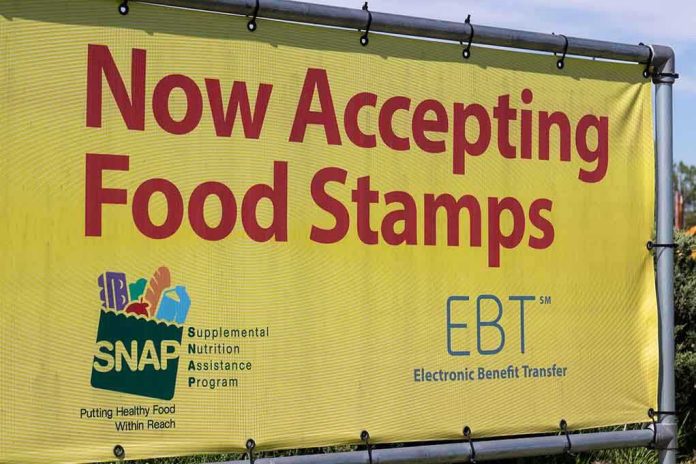
As inflation creeps back up and everyday Americans continue to feel the pinch at the grocery store, states are now staring down the barrel of a budget nightmare: being forced to pay for their own welfare spending, with less and less help from Washington.
At a Glance
- Inflation in the U.S. rose to 2.7% in June 2025, with food prices up even higher.
- States may need to fund more of their own health care and food assistance programs as federal support wanes.
- Taxpayers could face higher taxes or see state services slashed to cover ballooning welfare costs.
- The Oregon Health Plan’s history shows both the risks and realities of state-funded welfare programs.
States Grapple With Soaring Welfare Costs Amid Rising Inflation
Inflation is back in the headlines, and not in a good way. The U.S. Consumer Price Index climbed 2.7% in June, outpacing last month’s 2.4% jump and hitting its highest annual rate since February. Food prices are running even hotter—up 3% over the past year. Eggs are up a staggering 27.3%, with coffee and ground beef not far behind. This is not just a number-cruncher’s problem. Every trip to the grocery store is a reminder that your dollar’s worth less today than it was yesterday. And now, as if families haven’t been squeezed enough, states are facing the ugly truth that they may soon be on the hook for funding their own big-ticket welfare programs as federal dollars dry up. That means more taxes, more budget cuts, or both.
With core inflation (that’s everything except food and energy) ticking up to 2.9%, and the essentials getting pricier by the month, state budgets are stretched thin. The federal government has signaled it won’t keep bailing out state welfare programs forever, especially as national spending priorities shift. While some blue states have long lobbied for bigger, broader welfare rolls, the era of endless federal funding is coming to a close. Now the question is, who foots the bill when the check from Washington stops coming?
Oregon: The Cautionary Tale for State Welfare Schemes
Look no further than Oregon for a taste of what happens when states go it alone. Back in 1994, Oregon launched its much-hyped Health Plan, a first-of-its-kind experiment in expanding health care to the working poor. The catch? The state had to publicly rank—yes, rank—which health services it would pay for, rationing care in a way that made headlines nationwide. The plan was supposed to be a model of progressive innovation, but it quickly ran into the same brick wall every big government program eventually does: the bottom line. As costs skyrocketed, Oregon had to slash benefits, freeze enrollments, and scramble for ways to fund even basic services. Even with a federal waiver, the state’s taxpayers ended up shouldering more of the load, and tough choices had to be made about who gets what. The Oregon Health Plan is still limping along, but it’s a warning shot for any state thinking they can have it all without eventually sending the bill to their own citizens.
State officials may talk a big game about “moral obligations” and “public investments,” but reality bites hard when the money runs out. The debate over Medicaid and food assistance isn’t just about compassion—it’s about arithmetic. As Oregon found out, you can only stretch a dollar so far before someone pays the price, whether it’s the taxpayer or the person denied coverage when budgets run dry.
Taxpayers Face a No-Win Scenario: Higher Taxes or Fewer Services
Who stands to lose the most if states are forced to fund their own welfare expansions? Everyday taxpayers, that’s who. If your state decides to keep the welfare spigot wide open, you can expect to see your taxes climb or other critical services gutted. It’s a classic case of robbing Peter to pay Paul. As Oregon’s roller-coaster history proves, the promise of more government “freebies” always comes with a catch. When federal funding gets tight, states have to scramble to make up the difference, often at the expense of roads, schools, and law enforcement. Meanwhile, the very people these programs are meant to help—low-income families—are left in limbo, never knowing if coverage will be there next year or next month.
The underlying issue is simple: government can’t spend money it doesn’t have. For years, politicians have kicked the can down the road, printing money and pushing unfunded mandates on states and local communities. But the bill always comes due. As inflation eats away at paychecks, and as the cost of everything from gas to ground beef keeps climbing, voters are right to demand accountability and common sense from their leaders. If states want to offer Cadillac welfare programs, they need to be honest about who’s paying—and what’s getting cut to make room for it.
The Bottom Line: Hard Choices Ahead as Inflation Bites and Federal Aid Fades
With inflation now at its highest in months and core necessities taking a bigger bite out of family budgets, the prospect of states being left to fund their own welfare programs is not just a policy debate—it’s a fiscal train wreck in the making. Oregon’s cautionary tale should be required reading for every lawmaker: you cannot spend your way to prosperity, and you cannot promise the world without first checking the price tag. If there’s one thing Americans have learned over the last few years, it’s that government overreach, runaway spending, and endless “free” programs always end up costing more than advertised. As the federal government steps back, states that want to keep expanding benefits will have to make the tough, honest choice: raise taxes, cut services, or finally admit that sometimes, less government really is better for everyone.
For taxpayers and families already stretched to the breaking point, that’s the bitter reality. The days of endless bailouts are over. It’s time for state leaders to face the music and remember that every dollar spent comes from someone’s wallet—usually yours.
Sources:
CPI rose in June to 2.7% annual rate, highest since February
What is the current inflation rate in the US?
Consumer Price Index News Release – 2025 M06 Results









